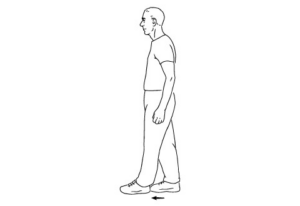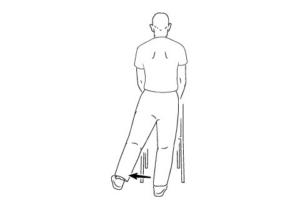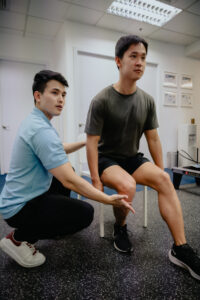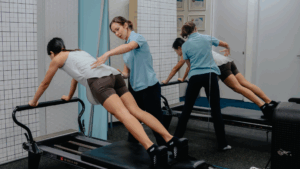In the realm of physical well-being, maintaining a steady balance is often underestimated in its importance. We may not think about it much, but balance is the foundation upon which our daily activities and movements rest. That’s where balance exercises in physiotherapy come into play, offering a holistic approach to enhancing stability, preventing injuries, and contributing to overall wellness. Let’s delve right in!
What is a balance exercise?
 A balance exercise is a specific physical activity aimed at improving and maintaining an individual’s equilibrium. These exercises challenge your body’s stability by engaging various muscles and neural pathways responsible for coordination. They require controlled movement and mental focus, making them an essential component of physiotherapy routines.
A balance exercise is a specific physical activity aimed at improving and maintaining an individual’s equilibrium. These exercises challenge your body’s stability by engaging various muscles and neural pathways responsible for coordination. They require controlled movement and mental focus, making them an essential component of physiotherapy routines.
What are the benefits of balance exercises in physiotherapy?
The benefits of incorporating balance exercises into your physiotherapy routine are wide-ranging and impactful. Beyond the obvious enhancement of stability, these exercises contribute to better posture, increased core strength, and improved muscle coordination. Moreover, they play a crucial role in injury prevention, making them a cornerstone of rehabilitation programs.
How do balance exercises enhance physical rehabilitation?
Balance exercises provide a bridge between the early stages of recovery and the return to daily activities. By challenging your body’s balance mechanisms, these exercises gently push you to regain muscle strength, joint stability, and overall mobility. These exercises are carefully selected to bolster muscle strength around the affected area, restore joint stability, and enhance your body’s proprioceptive awareness.
Much like placing a puzzle piece in its rightful spot, balance exercises are slotted into your regimen to strengthen the areas that require attention, ultimately contributing to a comprehensive and well-rounded recovery journey. Through the guidance of physiotherapists, these exercises become not just movements but stepping stones towards regaining control, confidence, and a higher quality of life.
Are balance exercises effective for improving stability?
Absolutely. When you engage in balance exercises, you challenge the proprioceptive system – the network of sensors that informs your brain about your body’s position in space. With each deliberate shift in weight, controlled movement, and steady stance, you set this network into action, prompting your brain to recalibrate its understanding of your body’s position in space.
Consistency is the key that unlocks the full potential of this transformation. The once-seemingly-challenging exercises begin to feel more manageable, and the benefits ripple outward into your everyday life. The enhanced proprioception, now a part of your body’s repertoire, translates into improved posture, greater steadiness during dynamic movements, and a heightened ability to adapt to varied surfaces and environments. This is most beneficial for those who are more prone to serious injuries from falls, such as the elderly.
How do balance exercises contribute to injury prevention?
Beyond recovery, balance exercises have a proactive role in preventing injuries. As you train your body to maintain balance in different scenarios, you develop better spatial awareness and reflexes. This translates into reduced chances of tripping, falling, or sustaining injuries during everyday activities.
What’s more, the expertise of physiotherapists takes injury prevention to a higher level. These professionals are adept at identifying potential weaknesses, imbalances, and areas of concern in your body. By working closely with a physiotherapist, you can receive targeted exercises and guidance that not only strengthen your body but also fortify areas prone to injury. This collaborative approach empowers you with the tools to lead a healthy and carefree life, where the risk of injuries becomes minimised, and your confidence in navigating the world around you grows substantially.
Can balance exercises aid in restoring mobility?
 For those who have experienced reduced mobility due to injuries or health conditions, balance exercises can be a game-changer. They work on multiple fronts – building muscle strength, improving joint mobility, and fine-tuning coordination. This comprehensive approach can help you regain your mobility and independence. This is most beneficial for the following groups of people:
For those who have experienced reduced mobility due to injuries or health conditions, balance exercises can be a game-changer. They work on multiple fronts – building muscle strength, improving joint mobility, and fine-tuning coordination. This comprehensive approach can help you regain your mobility and independence. This is most beneficial for the following groups of people:
Post-Surgery Patients: Individuals recovering from surgical procedures, such as joint replacements or ligament repairs, often experience reduced mobility due to the healing process. Balance exercises can aid in rebuilding muscle strength, joint stability, and overall coordination, facilitating a smoother and quicker recovery.
Elderly Individuals: Age-related factors can lead to decreased mobility and balance issues. Balance exercises help older adults improve muscle strength, proprioception, and reflexes, reducing the risk of falls and enhancing their ability to engage in daily activities.
Those with Sedentary Lifestyles: People who have been sedentary for extended periods, whether due to desk jobs or a lack of physical activity, can experience muscle imbalances and reduced mobility. Balance exercises are valuable in counteracting these effects and restoring overall mobility.
In essence, balance exercises are a versatile tool for restoring mobility in various populations. To reap the maximum benefits, it’s recommended to work with a qualified physiotherapist who can tailor exercises to individual needs and provide guidance on safe and effective progression.
Which balance exercises are recommended by physiotherapists?
Some common exercises include single-leg stands, heel-to-toe walking, and standing on an unstable surface. These exercises engage different muscle groups and help train your body to respond to various balance-related situations. Here are more details on some common balance exercises recommended by our physiotherapists:
Single-leg stands for balance training
How: Stand on one leg while maintaining your balance for 20-30 seconds. Gradually increase the duration as your balance improves.

Why: Single-leg stands are key for balance training, strengthening muscles and improving coordination. By challenging stability on one leg, you enhance control over movements and reduce the risk of falls. This exercise forms a strong foundation for better balance in daily activities.
Heel-to-toe walking for balance and control
How: Walk in a straight line, placing the heel of one foot directly in front of the toes of the other foot with each step.

Why: By walking in a straight line with one foot’s heel touching the toes of the other, you challenge your body’s balance and proprioceptive awareness. This exercise enhances your ability to control your movements and maintain steady footing, improving your overall balance. Incorporating heel-to-toe walking into your routine hones your balance skills, making everyday activities safer and more stable.
Side leg raise to promote stability and muscle coordination
How: Stand upright and slowly lift one leg out to the side, then lower it back down. Repeat on the other side.

Why: By lifting one leg out to the side while standing, you engage hip and core muscles, promoting better control over lateral movements. This exercise enhances your ability to maintain balance during shifts in weight and strengthens supporting muscles. Integrating side leg raises into your routine enhances your overall balance, helping you move with greater confidence and steadiness in various activities.
Calf raises for lower body strength and stability
How: Rise up on your toes while standing, then lower your heels back down. Repeat this in sets of 10.

Why: By rising up on your toes while standing and then lowering your heels, you engage calf muscles, which play a crucial role in maintaining balance and supporting body weight. This exercise not only enhances the strength of your calf muscles but also contributes to improved proprioception and control over foot movements. Incorporating calf raises into your routine builds a strong foundation for better balance, enabling you to move with greater confidence and stability in various situations.
Eyes closed balance test for increased movement control
How: Try some of the above exercises with your eyes closed to challenge your proprioceptive system.
Why: By closing your eyes while performing balance exercises, you rely more on your body’s internal sensors to maintain equilibrium. This exercise sharpens your body’s ability to respond to shifts in weight and movement without visual cues. Incorporating eyes closed balance training into your routine enhances your overall balance and spatial awareness, preparing you to navigate real-world scenarios with increased confidence and improved stability.
Not all balance exercises are right for everyone
The realm of recommended balance exercises is a dynamic landscape that depends greatly on your individual condition, goals, and physical capabilities. While there are general balance exercises that hold universal benefits, the true effectiveness lies in tailoring these exercises to suit your unique circumstances.
Are there specialised balance exercises for different conditions?
Yes! This is where the expertise of an experienced physiotherapist comes into play. Through a comprehensive assessment of your condition, medical history, and current physical state, our skilled physiotherapists can craft a personalised regimen that addresses your specific needs. Whether you’re recovering from an injury, managing a chronic condition, or seeking to enhance your overall stability, booking a consultation with a seasoned physiotherapist is the pivotal step that ensures you receive the most effective and appropriate balance exercises for your journey towards improved wellbeing.
Ready to start incorporating balance exercises into your life?
Here are some things to take note of before starting. Ensuring your safety and maximising the benefits of these exercises require a thoughtful approach. It’s important to be mindful of safety measures, take necessary precautions, and maintain consistency in your practice. By understanding these key aspects, you can embark on your balance exercise journey with confidence and set yourself up for a successful and rewarding experience.
How to safely begin balance exercises in your routine?
 If you’re new to balance exercises, it’s essential to start slowly and safely. Begin with basic exercises that you feel comfortable with, such as simple standing balance poses. As you build confidence and strength, gradually progress to more complex exercises that challenge your stability.
If you’re new to balance exercises, it’s essential to start slowly and safely. Begin with basic exercises that you feel comfortable with, such as simple standing balance poses. As you build confidence and strength, gradually progress to more complex exercises that challenge your stability.
What makes this journey even more effective is the guidance of a skilled physiotherapist. These professionals are adept at creating a tailored plan that aligns with your current abilities and individual progress. They understand that each person’s journey towards improved balance is unique and must be approached with patience and precision.
This customised approach ensures that you’re consistently challenged while avoiding unnecessary strain, allowing you to steadily advance through a series of exercises that gradually increase in difficulty. This progression not only optimises your results but also instils a sense of accomplishment as you witness your capabilities expand with each well-executed movement.
What precautions should you take during balance training?
As with any form of exercise, balance training also requires precautions. Ensure you have a stable support nearby, especially when starting. If you have specific health concerns, consult your physiotherapist before attempting new exercises. Safety should always be a priority.
Is consistency key to achieving results with balance exercises?
Like any form of exercise, consistent practice yields the best outcomes. Set realistic goals, make balance exercises a regular part of your routine, and enjoy the gradual improvements in stability, strength, and overall well-being.
While the concept of consistency might seem straightforward, its execution can sometimes be challenging. That’s where the expertise of a skilled physiotherapist becomes invaluable. Engaging a physiotherapist offers you a roadmap that guides your consistency with purpose and precision. These professionals not only craft a personalised plan tailored to your needs and goals but also provide the necessary accountability to keep you on track.
Their guidance goes beyond merely instructing exercises; they monitor your progress, make necessary adjustments, and celebrate your milestones. This collaborative partnership reinforces your commitment, making it easier to stick to your routine and unlock the incremental progress that comes with consistent effort.
Balance exercises & physiotherapy’s vital role
In the intricate tapestry of well-being, balance exercises emerge as a vibrant thread that weaves together the realms of stability, mobility, and holistic health. These exercises, rooted in the science of movement and healing, hold the potential to transform not just your body, but your entire approach to wellness. From restoring mobility after injuries to preventing future mishaps, balance exercises offer a comprehensive solution that goes beyond the surface to build strength, coordination, and confidence from within.
Our expert physiotherapists stand ready to craft a personalised roadmap, tailored to your unique circumstances, and guide you towards success. Their understanding of your needs, coupled with their professional insight, transforms balance exercises from mere movements into a powerful tool for holistic growth.
Are you ready to experience the transformative potential of balance exercises and pave the way to a life of stability and vigour? Take the next step by booking a consultation with any of our skilled physiotherapists today.
FAQs
Is core strength linked to improved balance through exercise?
 Absolutely, core strength and improved balance share a symbiotic relationship. Your core muscles, including those in your abdomen, back, and hips, form the central stabilising unit of your body. When these muscles are strong, they provide a solid foundation for movement and help maintain your body’s equilibrium.
Absolutely, core strength and improved balance share a symbiotic relationship. Your core muscles, including those in your abdomen, back, and hips, form the central stabilising unit of your body. When these muscles are strong, they provide a solid foundation for movement and help maintain your body’s equilibrium.
Engaging in exercises that target and strengthen your core contributes to better posture, stability, and overall balance. As your core muscles become more adept at supporting your body, you’ll notice an increased ability to maintain steady footing, navigate uneven terrain, and perform everyday activities with greater ease.
What is the efficacy of balance exercises?
Research consistently highlights the efficacy of balance exercises in improving stability, preventing falls, and enhancing overall well-being. Numerous studies have shown that structured balance training programmes lead to increased muscle strength, improved proprioception, and better coordination. This translates to a reduced risk of falls, particularly in populations vulnerable to balance-related issues such as the elderly or those recovering from injuries.
Moreover, these exercises have been found to have positive effects on functional abilities, supporting the seamless integration of enhanced balance into daily activities. The collective body of research underscores the transformative potential of balance exercises as a powerful tool in promoting physical resilience and longevity.
What are the psychological benefits of balance training?
Balance training offers more than just physical rewards – it extends its benefits to psychological well-being as well. Engaging in balance exercises requires focus, concentration, and mindfulness, creating a unique avenue for stress reduction and mental relaxation. As you immerse yourself in these exercises, you establish a connection between your body and mind, fostering a sense of presence and heightened awareness. The sense of accomplishment that comes with mastering new balance challenges boosts your confidence and self-esteem, creating a positive feedback loop that resonates in various aspects of your life.
Additionally, the mental engagement required in balance training serves as a distraction from daily stresses, contributing to improved mood and mental clarity. This holistic approach to well-being ensures that balance training isn’t just about physical fitness – it’s about nurturing a balanced and resilient mind as well.










